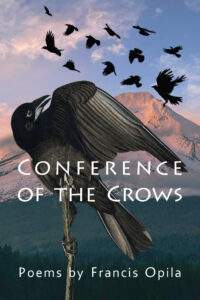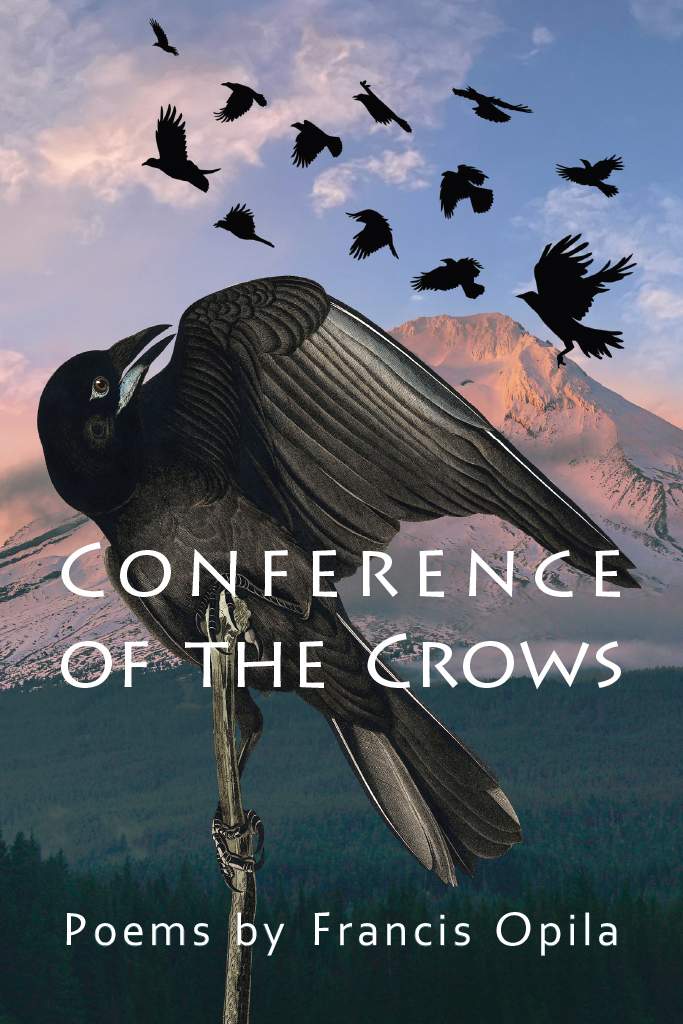Reviewed by Paul Telles
Conference of the Crows by Francis Opila
Just a Lark Books, 2023, 105 pages, $15
ISBN 979-8890345523
Available at https://francisopila.com/books/
In his debut collection, Portland poet Francis Opila engages the landscape of the Pacific Northwest with an endearing intimacy that brings a fresh perspective to familiar environmental themes. Throughout the book’s 65 poems, Opila observes and identifies with plants, animals, and indigenous peoples as he immerses himself in Northwest geography. He looks unflinchingly at the devastation wrought by Europeans.
In some poems, Opila approaches the landscape and its creatures with shamanic identification made believable because it is leavened by humor and contemporary sensibility. In the title poem, “Conference of the Crows,” Opila assumes the identity of a crow working his way through today’s fraught landscape.
The poem opens with a family of crows gathering in a live oak as dusk settles over the urban canopy. After asking if humans ever wonder what crows caw about, the speaker describes their conversations as raucous and bold / all about the day’s travels, which include encounters with hawks, ospreys, and with humans who provide dubious nourishment: McDonald’s fries, / cheese puffs on the roadway, pizza crust…
Ultimately, the poem is about the crows’ community:
As the moon rises, we settle,
we preen each other, snuggle
on the branches of that old oak.
As the poem moves toward its close, the crows’ great-grandbird leads them into the dream world of their past by relating a creation myth similar to tales from several Native American traditions. Once, the crows’ storyteller says, crows were white and men were few. Later, the crows were blackened by fire and gifted with magic so that, ironically, men multiplied, foraging became easy.
When the crows settle into their roost for the night, that ancient oak, the poem ends with a wry suggestion that the speaker may not be entirely comfortable among this tight-knit clan:
You may wonder:
How does one rebel in a murder of crows?
Hell if I know.
After this promising beginning, Conference of the Crows takes us on a four-part journey where an embodied love of the natural world provokes environmental awareness. In some poems, Opila enters the landscape with agency, reflecting on his own experience; in others, he disappears, becoming a near-pure observer intent on seeing the world as concretely as possible.
In “Sometimes I Visit the River,” Opila longs for anonymity and solitude, but does not disappear during the act of observation. The 19-line poem begins with Opila hoping to find the river free of other visitors so that he alone can savor a spot where rapids warble / osprey dives / kingfisher rattles / steelhead leaps.
The second stanza expands this dream of solitude until the poem closes with a surprising, but apt, reflection :
… I sing to distant stars,
letting my questions linger
unanswered, trusting only
the new dawn light.
In “High Tide Line / Unresolved,” Opila never uses the word, “I,” as he celebrates the Pacific Ocean and decries the extent of human pollution. Expertly handling a single sentence that spans all 46 lines of the poem, Opila builds a chanting rhythm that enables the poem to move smoothly from awestruck description to outrage to grief.
The poem begins with an observation of the ocean’s beauty that deftly blends sight and hearing—Color sings off the ocean / sunlight plays azure / aquamarine, surf blue. Gradually, the poem focuses on veins of unnatural color appearing in the surf—faded reds, yellow, blue / … magenta, cyan, which sets the stage for an expansive list of human garbage:
plastic bits, kaleidoscope
of broken jugs, torn fish nets,
six-pack rings straws, bottles,
once drinking water, Coca Cola,
Nestle, Amcor, Unilever, PepsiCo,
petroleum, now pelagic trash…
The poem next works through an explosive series of plastics beginning with “p”—polyethylene, polypropylene, / polyvinyl chloride, polystyrene—before cataloging the damage they do to wildlife. Coated with algae, the trash is consumed by albatross, / shearwaters, petrels, / stomachs ruptured.
Relentlessly, the poem surges forward to show us plastic shards, fibers, / fragments, microbeads, / nanoplastic soup before coming to rest on the Oregon north coast beach, / high tide line… broken blanched, / forever adrift.
Other poems find Opila pondering a mole, watching a weaver at work and, in a complex, six-page poem, re-imagining Woody Guthrie’s “Roll On, Columbia” in free-verse that envisions the Columbia River returning to its wild state.
Written over the course of a dozen years, the poems in The Conference of the Crows demonstrate that Opila’s growth as a poet was directly connected to his embrace of the Oregon landscape. Each of his impulses deepened the other. Consequently, the poems present familiar Northwest locations in a way that is unique to Opila, but easily embraced by any reader who loves our part of the world.
Revier Bio:
Paul Telles is a former journalist and lifelong reader of poetry who thinks retirement is a self-funded writing fellowship. His poems have appeared or will soon appear in Alaska Quarterly Review, The Westchester Review, The Still Point Arts Quarterly, The Inflectionist Review, Boomer LitMag, and other publications. He has won several OPA prizes, including first place in the Members Only category in 2025. Paul received his MFA from Pacific University in January 2024.

